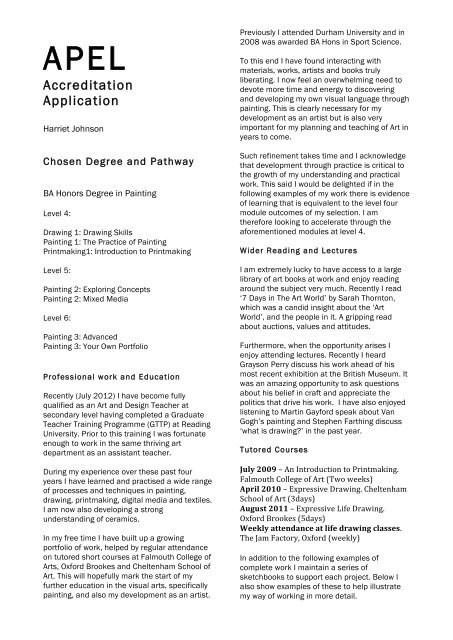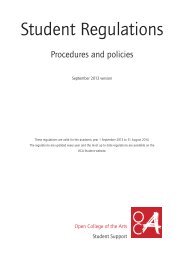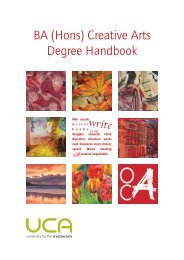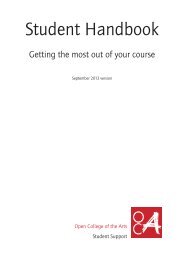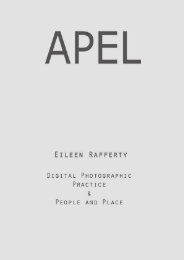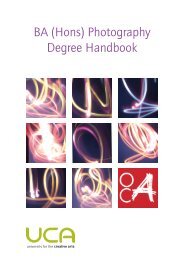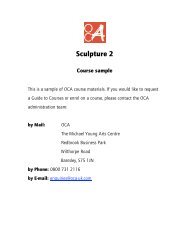Accreditation Application - Open College of the Arts
Accreditation Application - Open College of the Arts
Accreditation Application - Open College of the Arts
Create successful ePaper yourself
Turn your PDF publications into a flip-book with our unique Google optimized e-Paper software.
APEL<br />
<strong>Accreditation</strong><br />
<strong>Application</strong><br />
Harriet Johnson<br />
Chosen Degree and Pathway<br />
BA Honors Degree in Painting<br />
Level 4:<br />
Drawing 1: Drawing Skills<br />
Painting 1: The Practice <strong>of</strong> Painting<br />
Printmaking1: Introduction to Printmaking<br />
Level 5:<br />
Painting 2: Exploring Concepts<br />
Painting 2: Mixed Media<br />
Level 6:<br />
Painting 3: Advanced<br />
Painting 3: Your Own Portfolio<br />
Pr<strong>of</strong>essional work and Education<br />
Recently (July 2012) I have become fully<br />
qualified as an Art and Design Teacher at<br />
secondary level having completed a Graduate<br />
Teacher Training Programme (GTTP) at Reading<br />
University. Prior to this training I was fortunate<br />
enough to work in <strong>the</strong> same thriving art<br />
department as an assistant teacher.<br />
During my experience over <strong>the</strong>se past four<br />
years I have learned and practised a wide range<br />
<strong>of</strong> processes and techniques in painting,<br />
drawing, printmaking, digital media and textiles.<br />
I am now also developing a strong<br />
understanding <strong>of</strong> ceramics.<br />
In my free time I have built up a growing<br />
portfolio <strong>of</strong> work, helped by regular attendance<br />
on tutored short courses at Falmouth <strong>College</strong> <strong>of</strong><br />
<strong>Arts</strong>, Oxford Brookes and Cheltenham School <strong>of</strong><br />
Art. This will hopefully mark <strong>the</strong> start <strong>of</strong> my<br />
fur<strong>the</strong>r education in <strong>the</strong> visual arts, specifically<br />
painting, and also my development as an artist.<br />
Previously I attended Durham University and in<br />
2008 was awarded BA Hons in Sport Science.<br />
To this end I have found interacting with<br />
materials, works, artists and books truly<br />
liberating. I now feel an overwhelming need to<br />
devote more time and energy to discovering<br />
and developing my own visual language through<br />
painting. This is clearly necessary for my<br />
development as an artist but is also very<br />
important for my planning and teaching <strong>of</strong> Art in<br />
years to come.<br />
Such refinement takes time and I acknowledge<br />
that development through practice is critical to<br />
<strong>the</strong> growth <strong>of</strong> my understanding and practical<br />
work. This said I would be delighted if in <strong>the</strong><br />
following examples <strong>of</strong> my work <strong>the</strong>re is evidence<br />
<strong>of</strong> learning that is equivalent to <strong>the</strong> level four<br />
module outcomes <strong>of</strong> my selection. I am<br />
<strong>the</strong>refore looking to accelerate through <strong>the</strong><br />
aforementioned modules at level 4.<br />
Wider Reading and Lectures<br />
I am extremely lucky to have access to a large<br />
library <strong>of</strong> art books at work and enjoy reading<br />
around <strong>the</strong> subject very much. Recently I read<br />
‘7 Days in The Art World’ by Sarah Thornton,<br />
which was a candid insight about <strong>the</strong> ‘Art<br />
World’, and <strong>the</strong> people in it. A gripping read<br />
about auctions, values and attitudes.<br />
Fur<strong>the</strong>rmore, when <strong>the</strong> opportunity arises I<br />
enjoy attending lectures. Recently I heard<br />
Grayson Perry discuss his work ahead <strong>of</strong> his<br />
most recent exhibition at <strong>the</strong> British Museum. It<br />
was an amazing opportunity to ask questions<br />
about his belief in craft and appreciate <strong>the</strong><br />
politics that drive his work. I have also enjoyed<br />
listening to Martin Gayford speak about Van<br />
Gogh’s painting and Stephen Farthing discuss<br />
‘what is drawing?’ in <strong>the</strong> past year.<br />
Tutored Courses<br />
July 2009 – An Introduction to Printmaking. <br />
Falmouth <strong>College</strong> <strong>of</strong> Art (Two weeks) <br />
April 2010 – Expressive Drawing. Cheltenham <br />
School <strong>of</strong> Art (3days) <br />
August 2011 – Expressive Life Drawing. <br />
Oxford Brookes (5days) <br />
Weekly attendance at life drawing classes. <br />
The Jam Factory, Oxford (weekly) <br />
In addition to <strong>the</strong> following examples <strong>of</strong><br />
complete work I maintain a series <strong>of</strong><br />
sketchbooks to support each project. Below I<br />
also show examples <strong>of</strong> <strong>the</strong>se to help illustrate<br />
my way <strong>of</strong> working in more detail.
APEL <strong>Application</strong> <br />
Details <strong>of</strong> Selected Works<br />
Drawing and Painting<br />
The following images have been selected to<br />
demonstrate <strong>the</strong> various ways I believe I have<br />
met <strong>the</strong> learning objectives and outcomes at<br />
level four in my chosen disciplines. The<br />
concepts and ideas that have informed my<br />
practical work are discussed alongside <strong>the</strong><br />
methods and processes used. These reflections<br />
are carefully considered and personal but I<br />
have also tried to maintain a sufficient degree<br />
<strong>of</strong> objectivity as well. I have included examples<br />
<strong>of</strong> preparatory drawings, final pieces and<br />
examples <strong>of</strong> sketchbook work here.<br />
The beauty <strong>of</strong> organic objects has inspired<br />
much <strong>of</strong> my work; seeds, fruit, pods and flowers<br />
to name a few. Drawing allows me to<br />
permanently record <strong>the</strong> shape, tone (at that<br />
given moment) and texture <strong>of</strong> such objects. This<br />
lets me make more sense <strong>of</strong> what I am<br />
observing and streng<strong>the</strong>ns <strong>the</strong> relationship I<br />
have with that piece <strong>of</strong> work. These images are<br />
examples <strong>of</strong> observational drawing made using<br />
pencil on cartridge paper. All are underpinned<br />
by my belief in <strong>the</strong> importance <strong>of</strong> accurate<br />
observation in <strong>the</strong> early stages <strong>of</strong> a project.<br />
Pencil on cartridge paper<br />
Pencil on cartridge paper<br />
Pencil on cartridge paper<br />
Page 2
APEL <strong>Application</strong> <br />
In addition I feel it is also extremely rewarding<br />
to experiment with a greater degree <strong>of</strong><br />
expression and interpretation in drawing. The<br />
following images demonstrate instances where<br />
I have enjoyed drawing for its own sake, without<br />
using it as a starting block for future work. I am<br />
particularly pleased with my use <strong>of</strong> colour in<br />
<strong>the</strong>se drawings and would like to experiment<br />
fur<strong>the</strong>r with more unusual combinations.<br />
Indian ink and watercolor<br />
Oil pastel on tissue paper<br />
Indian ink and acrylic on a Monoprint background<br />
Blind drawing using pen on paper<br />
One technique I have become fascinated in is<br />
Blind Drawing. In particular I enjoy <strong>the</strong> feeling <strong>of</strong><br />
deception when you have no idea what your<br />
drawing looks like and <strong>the</strong> unedited response to<br />
what you are drawing. This led me to produce<br />
<strong>the</strong> following ‘captions’ made from blind selfportraits,<br />
embroidered on cotton and paper<br />
freehand on a sewing machine.<br />
Page 3
APEL <strong>Application</strong> <br />
As my work began to develop I started to<br />
become less interested in <strong>the</strong> quality <strong>of</strong> line<br />
used and more driven by <strong>the</strong> challenge <strong>of</strong><br />
demonstrating <strong>the</strong> form <strong>of</strong> <strong>the</strong> face. On<br />
reflection this was a pivotal point that led me to<br />
a large body <strong>of</strong> portraiture, and a much deeper<br />
understanding <strong>of</strong> how to use tone effectively in<br />
my work. Looking at <strong>the</strong> work <strong>of</strong> Marlena<br />
Dumas and Jesse Leroy-Smith (example <strong>of</strong> a<br />
sketchbook page below) prompted me to create<br />
<strong>the</strong> following self-portrait using watercolour and<br />
inks because <strong>of</strong> <strong>the</strong>ir fluid properties.<br />
Watercolour and ink on paper<br />
Working in this way prompted me to look at <strong>the</strong><br />
work <strong>of</strong> Schiele. I was inspired by <strong>the</strong><br />
combination <strong>of</strong> his manic mark making but<br />
gentle application <strong>of</strong> colour. The strength <strong>of</strong> line<br />
and <strong>the</strong> style <strong>of</strong> Calder’s work also captured my<br />
attention when making <strong>the</strong>se drawings.<br />
(Sketchbook page responding to Dumas’ work)<br />
Page 4
APEL <strong>Application</strong> <br />
A natural progression from here was to consider<br />
<strong>the</strong> properties <strong>of</strong> o<strong>the</strong>r materials and how <strong>the</strong>y<br />
could be used in a similar way. I played with oil<br />
paint investigating how it reacted to being<br />
diluted and combined with turpentine. I wanted<br />
to see if a similar effect could be achieved<br />
using this heavier more robust material and<br />
produced <strong>the</strong> following two portraits, taking only<br />
4 hours to create each one.<br />
Oil on canvass with newspaper cuttings<br />
Both oil on canvass with an acrylic ground<br />
This experimentation was interesting and<br />
certainly a lot <strong>of</strong> fun but I was not totally<br />
satisfied with <strong>the</strong> disjointed transition from <strong>the</strong><br />
fluid hair and shoulders to <strong>the</strong> more precise<br />
detail on <strong>the</strong> face. I soon started to return to a<br />
more traditional style <strong>of</strong> oil painting but made<br />
<strong>the</strong>m more contemporary by incorporating<br />
different materials within <strong>the</strong> painting. This<br />
included collaging paper cuttings and luggage<br />
tags onto <strong>the</strong> canvasses as demonstrated<br />
above, or giving <strong>the</strong> painting’s ground a more<br />
prominent part in <strong>the</strong> overall image like <strong>the</strong><br />
painting below.<br />
Both oil on canvass with an acrylic ground<br />
Acrylic on paper with collage<br />
Page 5
APEL <strong>Application</strong> <br />
Printmaking<br />
In July 2009 I completed a two-week<br />
Printmaking course run by Falmouth <strong>College</strong> <strong>of</strong><br />
<strong>Arts</strong>. In this body <strong>of</strong> work named ‘Fruition’ I<br />
wanted to mutate <strong>the</strong> meaning and expectation<br />
<strong>of</strong> natural structures that we encounter<br />
everyday. This was my attempt <strong>of</strong> highlighting<br />
how unfamiliar we actually are with <strong>the</strong> shapes,<br />
textures and patterns <strong>of</strong> objects that we think<br />
we know very well.<br />
Looking specifically at fruits I turned my<br />
observational drawings (some are shown on<br />
page 2) into microscopic cellular structures that<br />
look foreign and unfamiliar. During this process<br />
I enjoyed marrying <strong>the</strong> tight graphic effect <strong>of</strong><br />
drypoint etching with more fluid layers <strong>of</strong><br />
monoprints.<br />
Inspired by my painting experiments I loved<br />
working with turpentine again, dripping it onto a<br />
lightly inked plate. The oil-based ink made<br />
delicate rosettes <strong>of</strong> colour as it reacted with <strong>the</strong><br />
turpentine. Printing <strong>the</strong> residual pattern once<br />
<strong>the</strong> turpentine had evaporated allowed me to<br />
capture <strong>the</strong> temporary nature <strong>of</strong> this and<br />
complement <strong>the</strong> harsh drypoint lines with s<strong>of</strong>t<br />
fleshy marks. The following prints are samples<br />
<strong>of</strong> this technique.<br />
Drypoint Etching with Monoprint background<br />
Page 6
APEL <strong>Application</strong> <br />
During <strong>the</strong> course I was also able to practice<br />
limestone lithography, silkscreen printing and<br />
monoprinting using an <strong>of</strong>fset roller. All work<br />
made by <strong>the</strong>se techniques developed <strong>the</strong><br />
concept fur<strong>the</strong>r and were used in <strong>the</strong> later<br />
stages <strong>of</strong> <strong>the</strong> course. Colour, pattern and shape<br />
became <strong>the</strong> focus <strong>of</strong> my work as <strong>the</strong> resulting<br />
prints became fur<strong>the</strong>r removed from <strong>the</strong><br />
original drawings and more abstract as you can<br />
see below.<br />
Lithograph<br />
Monoprint using an <strong>of</strong>fset roller<br />
To conclude this body <strong>of</strong> work I felt it was<br />
appropriate to take <strong>the</strong> development just one<br />
step fur<strong>the</strong>r. I have always admired <strong>the</strong> work <strong>of</strong><br />
<strong>the</strong> Abstract Expressionists, particularly<br />
Rothko’s early ‘Multiforms’ with such lavish use<br />
<strong>of</strong> colour and fragile forms. My prints also<br />
began to remind me <strong>of</strong> Gillian Ayres’ paintings.<br />
Looking at her work in more depth I became<br />
curious as to how she would fill her<br />
compositions with patterns <strong>of</strong> dancing shapes. I<br />
found that this ‘naïve’ style <strong>of</strong> painting actually<br />
required much more precision and delicacy<br />
than first thought.<br />
Silkscreen Print with machine embroidery drawing<br />
Acrylic on canvas<br />
Page 7
APEL <strong>Application</strong> <br />
Painting and Drawing Continued<br />
The most recent project that I have been<br />
working on is based on <strong>the</strong> English East India<br />
Company in <strong>the</strong> 18 th century, specifically its tea<br />
trade. I wanted to comment on how <strong>the</strong> English<br />
gentry used tea as an indication <strong>of</strong> <strong>the</strong>ir<br />
financial and social status with probably very<br />
little appreciation for <strong>the</strong> workers in India who<br />
would pick, prepare and transport <strong>the</strong> tea.<br />
In an attempt to demonstrate that without<br />
<strong>the</strong>se workers <strong>the</strong> trade and social<br />
demonstrations would stop I took <strong>the</strong> following<br />
photographs. I began to gradually bind an<br />
original Edwardian teacup with images <strong>of</strong><br />
women transporting <strong>the</strong> tea on <strong>the</strong>ir backs.<br />
Interestingly when I smashed <strong>the</strong> teacup in<br />
order to show <strong>the</strong> fragility <strong>of</strong> <strong>the</strong> porcelain (a<br />
reflection <strong>of</strong> <strong>the</strong> weaknesses in valuing social<br />
importance) <strong>the</strong> fragments were held toge<strong>the</strong>r<br />
tightly by <strong>the</strong> workers. I took <strong>the</strong> following<br />
photographs at different stages <strong>of</strong> <strong>the</strong> process.<br />
Pencil on cartridge paper<br />
Oil on canvass<br />
Above are a drawing study from one <strong>of</strong> <strong>the</strong><br />
photographs and an oil painting from ano<strong>the</strong>r I<br />
decided to use a very precise way <strong>of</strong> painting<br />
and muted tones with a few accents <strong>of</strong> warm<br />
colour having been inspired by 16 th Century<br />
Dutch Still Life paintings. Below is an example<br />
<strong>of</strong> a quick mixed media study made in <strong>the</strong><br />
beginning <strong>of</strong> this project.<br />
Page 8
APEL <strong>Application</strong> <br />
An area that I would like to investigate fur<strong>the</strong>r is<br />
landscape painting and drawing. I am looking to<br />
attend a short course during <strong>the</strong> summer<br />
holiday. Having learned <strong>the</strong> basis <strong>of</strong> measuring I<br />
wanted to apply <strong>the</strong> same strategy to<br />
landscapes. The paintings I have produced rely<br />
on linear perspective to maintain correct<br />
proportions. Each perspective is slightly<br />
different and <strong>the</strong> subject matter varies from<br />
urban to rural.<br />
contrast <strong>the</strong> texture <strong>of</strong> <strong>the</strong> work. I am very<br />
pleased with <strong>the</strong> outcome and look forward to<br />
creating many more like it.<br />
Sketchbook work<br />
As previously mentioned I feel it is important to<br />
keep working sketchbooks when developing my<br />
ideas to document my findings. Below are a<br />
couple <strong>of</strong> pages taken from <strong>the</strong> sketchbooks<br />
that supports <strong>the</strong> work outlined on page 5.<br />
Watercolour on paper<br />
In this painting I was inspired by John Piper’s<br />
work, in particular his use <strong>of</strong> non-naturalistic<br />
colour. I am pleased with <strong>the</strong> overall effect <strong>of</strong><br />
this piece but feel that I could have achieved a<br />
greater contrast between <strong>the</strong> building and its<br />
surrounds like Piper does. Oxford was a<br />
wonderful place to work and this was made<br />
from direct observation <strong>of</strong> Christ Church<br />
<strong>College</strong>.<br />
Oil on Canvas<br />
This painting depicts my favorite holiday<br />
destination in Cornwall. It is a place where I feel<br />
at peace; an emotion that I wanted to portray in<br />
this painting. Using oils on an acrylic ground I<br />
enjoyed layering <strong>the</strong> paint spontaneously,<br />
making impasto marks in certain areas to<br />
Page 9
APEL <strong>Application</strong> <br />
Life Drawing<br />
Regular attendance at Life Drawing classes has<br />
allowed me to practise measuring techniques to<br />
maintain scale and proportion in my drawing.<br />
Recreating distance and foreshortening has<br />
been one <strong>of</strong> <strong>the</strong> main challenges in my work.<br />
Continuing along <strong>the</strong> same vein <strong>the</strong> image<br />
below was made using inks, water and pastel. It<br />
was a direct response <strong>the</strong> textures <strong>of</strong> <strong>the</strong> skin.<br />
The portrait was also observed from life but<br />
alternatively focuses on effective use <strong>of</strong> tone in<br />
portraiture.<br />
Line drawing in pencil on Fabriano paper<br />
I have also enjoyed approaching life drawing in<br />
a less conventional way. By using my nondominant<br />
hand I was able to make looser more<br />
unusual marks.<br />
Page 10


